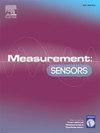High-fidelity EEG feature-engineered taxonomy for bruxism and PLMS prognostication through pioneering and avant-garde ML frameworks
Q4 Engineering
引用次数: 0
Abstract
Periodic Leg Movement during Sleep (PLMS) and Bruxism are linked with changes in EEG signal characteristics. This work applies machine learning and data mining approaches to examine these changes. Patients with PLMS and bruxism had nighttime EEG recordings to examine changes in brain activity. The findings revealed constant variations in brain hemodynamics even in the absence of clearly observable arousals in the EEG. Wavelet decomposition was used to improve classification precision. Using the N3 sleep stage, accuracy varied from 92 % to 96 %, with an AUC of 0.85–0.89, in diagnosing binary sleep disorders. Still, adding wavelet-based elements greatly enhanced performance, obtaining an AUC of 0.99 with classification accuracy ranging from 94 % to 98 %. This emphasizes how strongly discriminative power wavelet-extracted EEG characteristics possess. Using K-Nearest Neighbors (KNN), Artificial Neural Networks (ANN), and Support Vector Machines (SVM) with Radial Basis Function (RBF), Bruxism categorization was accomplished. These models attained respectively 82 %, 90 %, and 93 % percent classification accuracy. This work is the first to show a direct connection among differences in brain activity based on PLMS, Bruxism, and EEG-based technologies. The results show how well machine learning methods and EEG feature extraction might diagnose sleep problems. Although the therapeutic relevance of these findings is yet unknown, the results imply that enhanced EEG-based classification techniques could produce more reliable and automated diagnostic instruments for Bruxism and PLMS.
高保真脑电图特征工程分类法为磨牙症和PLMS预测通过开拓和前卫的ML框架
睡眠期间周期性腿部运动(PLMS)和磨牙症与脑电图信号特征的变化有关。这项工作应用机器学习和数据挖掘方法来检查这些变化。患有PLMS和磨牙症的患者有夜间脑电图记录,以检查大脑活动的变化。研究结果显示,即使在脑电图中没有清晰观察到的觉醒,脑血流动力学也会不断变化。采用小波分解提高分类精度。使用N3睡眠阶段,诊断二元睡眠障碍的准确率从92%到96%不等,AUC为0.85-0.89。然而,添加基于小波的元素大大提高了性能,获得了0.99的AUC,分类精度在94%到98%之间。这强调了功率小波提取的脑电特征具有很强的判别性。采用k近邻(KNN)、人工神经网络(ANN)和径向基函数支持向量机(SVM)对磨牙症进行分类。这些模型分别达到了82%、90%和93%的分类准确率。这项工作首次显示了基于PLMS、磨牙症和基于脑电图技术的大脑活动差异之间的直接联系。结果表明,机器学习方法和脑电图特征提取可以很好地诊断睡眠问题。虽然这些发现的治疗相关性尚不清楚,但结果表明,增强的基于脑电图的分类技术可以为磨牙症和PLMS提供更可靠和自动化的诊断工具。
本文章由计算机程序翻译,如有差异,请以英文原文为准。
求助全文
约1分钟内获得全文
求助全文
来源期刊

Measurement Sensors
Engineering-Industrial and Manufacturing Engineering
CiteScore
3.10
自引率
0.00%
发文量
184
审稿时长
56 days
 求助内容:
求助内容: 应助结果提醒方式:
应助结果提醒方式:


